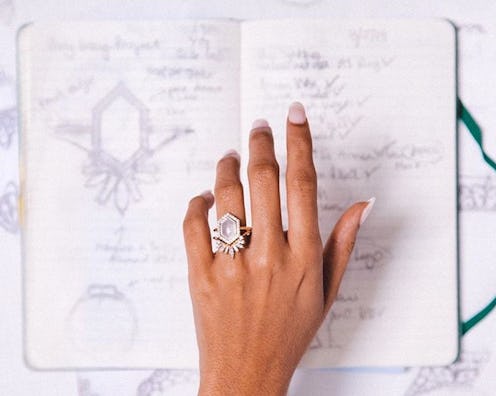(Fashion)
How COVID-19 Will Change The Way You Shop For An Engagement Ring

When the COVID-19 pandemic started to upend the fashion industry three months ago, Stephanie Wynne Lalin, co-founder of NYC-based fine jewelry brand Jemma Wynne, wasn’t sure how her business would fare. “It was a very scary situation where everything just came to a halt, and we didn’t know what was going to happen to the company or our clients,” she says of what her and her business partner, Jenny Klatt, were thinking. Today, they’ve found themselves pleasantly surprised by the amount of people still shopping for engagement rings during COVID-19. “We’ve been selling tons of jewelry and a ton of engagement rings,” Lalin shares, adding that their signature two-stone rings have been especially popular in recent months. “One of our clients had been emailing us on and off saying, ‘I think I’m ready… I’m not ready… let’s start… actually let’s hold off.’ And then COVID happened and he was like, ‘let’s do this.’”
In Los Angeles, designer Maggi Simpkins, who specializes in custom engagement rings, is having similar experiences. “I’ve been incredibly lucky that love isn’t cancelled,” Simpkins says. “For a lot of people, this time has put into perspective what’s really important. Couples are quarantined together and they're realizing that they’re ready [to get engaged], even without any real knowledge of when their weddings will happen.”
But while engagement rings are still very much in demand, designers are having to navigate showroom and boutique closures, making a process that often entails in-person appointments and consultations 100 percent digital.
“Just like any other industry, we’ve had to learn how to pivot,” says Grant Mobley, a diamond expert with the Natural Diamond Council. Much of Mobley’s work entails sharing industry trends and innovations with small, family-owned jewelry companies that rely heavily on business done in their brick and mortar boutiques. In the wake of COVID-19, he’s now working with jewelers to grow and refine their social media presence, ramp up e-commerce, and take a more virtual-first approach to business. “Pretty much every jeweler I know is doing video meetings, and showing people products virtually,” he adds, “but even before COVID my advice [for people shopping for engagement rings] was to really do your research online first. Instagram is an amazing place to find designs.”
Thus far, the transition for Simpkins has been relatively seamless. “I have a showroom in Los Angeles, but I would say 95 percent of my work is done digitally,” she says. Known for hiding details in her designs that are specific to a couple’s story — like a star constellation under a basket or a message inside a band — Simpkins’s process usually starts with an email or DM expressing interest in purchasing a ring. Once stone and style preferences are settled on, along with budget, sketches and 3D molds are shared with a client before the final piece is made and either shipped or picked up.
Having worked with numerous clients outside of NYC over the years, Lalin and Klatt have a time-tested approach to virtual collaboration. “If we have five stones for someone to choose from, we’ll lay them all out and label them, then take a video of each one on one of our hands so they can see the scale,” Lalin explains. “It’s always really important for someone to understand scale. Once we narrow down which stones to use, we’ll then take pictures and videos showing them in different settings. We’ve found that the best lighting is usually in the morning by a window, or right before dusk.”
In terms of trends, Mobley and Simpkins have noticed a slowed trend cycle with a continued preference towards popular 2019 styles, among them oval-shaped diamonds, yellow gold setting, and simplistic designs. “Ovals and pear shapes have been my number one sellers,” Simpkins says. “Everyone is asking for those.” Noting research from the Natural Diamond Council, Mobley says, “usually round diamonds are about 50 percent of all diamond sales for engagement rings, and the other 50 percent is made up of every other cut. Now we’re seeing the oval diamond account for more than 20 percent of all rings. People like the oval because it tends to look bigger on your finger.” Yellow gold, Simpkins says, is another common request. “A really simple yellow gold ring with a yellow gold bezel is timeless and the number one across the board cool-girl style.”
Of all the changes COVID has imposed on the industry, the most glaring seems to be that even with high demand, production is moving at a much slower pace. While Simpkins isn’t experiencing substantial supply chain delays, she says her clients have been “much more patient and relaxed with their timelines,” perhaps a result of the world at large coming to a bit of a standstill. And while it is taking Lalin and Klatt longer to source stones than it has in the past, the shift is welcome. “We were feeling before COVID that everything was very fast paced,” Lalin says. “Coming out with five or six collections a year was becoming a lot for us, and it was taking away from the romantic part of the process.” It’s a lesson they plan to carry through even after the pandemic subsides. “This time where we’ve been able to slow down a bit has been really amazing, both mentally and for our collection,” Lalin reflects. “We’ve been able to have a lot more communication with our clients and understand what they gravitate towards. Post COVID, I think we’ll probably slow down the collections a bit.”
Scroll down to shop some of TZR’s favorite engagement rings below.
We only include products that have been independently selected by The Zoe Report's editorial team. However, we may receive a portion of sales if you purchase a product through a link in this article.
This article was originally published on